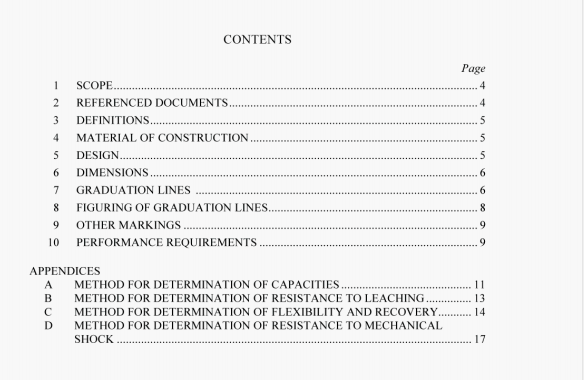AS 2770:2005 pdf – Measuring cylinders-Plastics—Graduated.
(ii) immediately above the long lines, to which they refer and slightly to the right of the adjacent shorter lines.
(f) lithe long lines are extended so as to almost encircle the cylinder, the ligures shall be placed either—
(i) immediately above the line: or
(ii) so as to occupy a break in the appropriate long lines located slightly to the right of the right-hand ends of the shorter lines.
9 OTHER MARKINGS
9.1 Nlandatorv markings
The following inscriptions shall be permanently and legibly marked on all cylinders:
(a) The smbol to indicate the unit of volume.
(b) The inscription in 20°C to indicate that the cylinder is graduated for content at
20°C.
(c) The name or an abbreviation of the name of the material from which the cylinder is made.
NOTE: This is of particular assistance in determining compatibility of the cylinder with solvents (see CAUTION in Clause 4).
9.2 Optional markings
The following marking may also be added at the discretion of the manufacturer/vendor:
(a) The maker’s and/or vendor’s name or mark readily identifying the maker/vendor.
(b) Reference to this Standard. i.e. AS 2770.
10 PERFORMANCE REQUIREMENTS
10.1 Accuracy of graduations
When the capacity is determined in accordance with Appendix A. the errors shall not exceed the maximum perniitted errors given in Table 2. Note that these errors represent the maximum permissible error at any point tested and also the maximum permissible difference between the errors at an two points.
10.2 Resistance to leaching
Wheti tested in accordance with Appendix B. the aqueous extract obtained from the cylinder shall be free of suspended matter, and the difference between the conductivity of this extract and that of the original water shall not exceed the apPropriate value given in Table 3.
A2 PROCEDURE
A2.1 Determination of apparent mass of waterThe procedure shall be as follows:
(a)Weigh the cleaned and dried measuring cylinder.
(b)Fill the cylinder with distilled or deionized water at room temperature to a few
millimetres above the graduation line to be tested,taking care to avoid wetting thecylinder above the water surface.
(c) Allow the cylinder to stand at room temperature for about 5 min to stabilize itstemperature.
(d) Measure the water temperature t to the nearest 1°C.(e)Stand the cylinder on a smooth, horizontal surface.
(f)Lower the meniscus of the water to the top edge of the selected graduation line by
withdrawing small amounts of water with a clean, glass dropping pipette. Ensure thatthe plane of the graduation line is tangential to the lowest point of the meniscus, theline of sight being in the same plane.
(g) Weigh the cylinder plus contents and determine the apparent mass of the water in thecylinder.
(h) From the apparent mass calculate the volume of water at 20C contained in the
cylinder up to the graduation line tested by applying a correction for water temperature as described in Paragraph 2.2.
AS 2770:2005 pdf – Measuring cylinders-Plastics—Graduated
